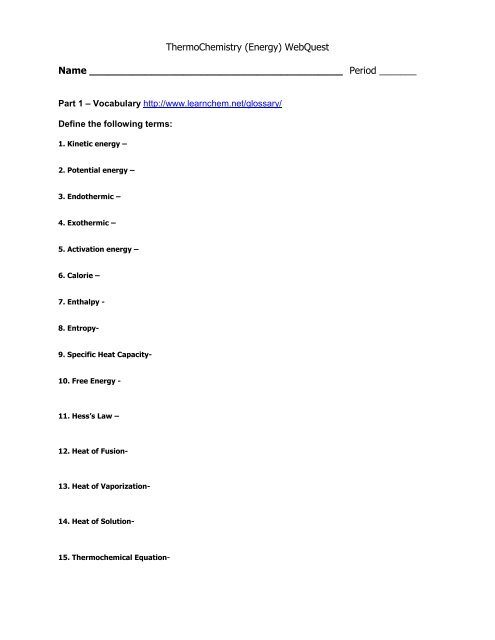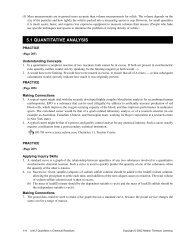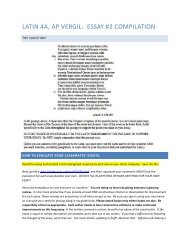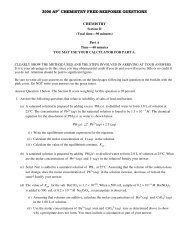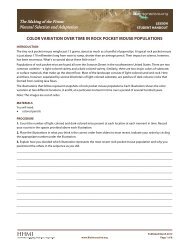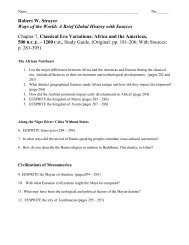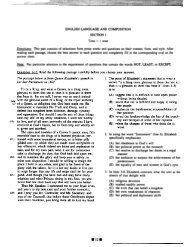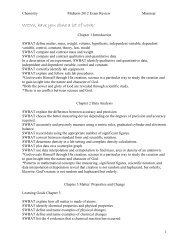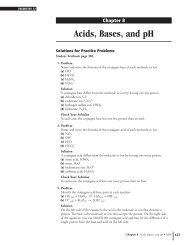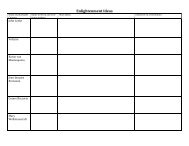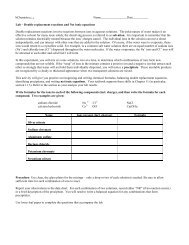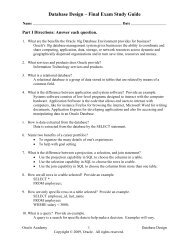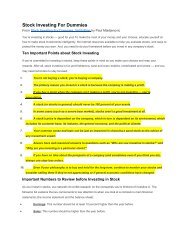Thermochemistry Webquest worksheet - Quia
Thermochemistry Webquest worksheet - Quia
Thermochemistry Webquest worksheet - Quia
Create successful ePaper yourself
Turn your PDF publications into a flip-book with our unique Google optimized e-Paper software.
ThermoChemistry (Energy) WebQuest<br />
Name _________________________________________ Period _______<br />
Part 1 – Vocabulary http://www.learnchem.net/glossary/<br />
Define the following terms:<br />
1. Kinetic energy –<br />
2. Potential energy –<br />
3. Endothermic –<br />
4. Exothermic –<br />
5. Activation energy –<br />
6. Calorie –<br />
7. Enthalpy -<br />
8. Entropy-<br />
9. Specific Heat Capacity-<br />
10. Free Energy -<br />
11. Hess’s Law –<br />
12. Heat of Fusion-<br />
13. Heat of Vaporization-<br />
14. Heat of Solution-<br />
15. Thermochemical Equation-
ThermoChemistry (Energy) WebQuest<br />
Name _________________________________________ Period _______<br />
Part 2 - Reaction Rates<br />
http://www.mhhe.com/physsci/chemistry/essentialchemistry/flash/activa2.swf<br />
Listen to the introduction.<br />
Play & Listen to the Exothermic & Endothermic Reaction animation.<br />
Draw an exothermic & endothermic energy profile<br />
Label: axes, reactants, products, activation energy, activated complex, heat of<br />
reaction<br />
Exothermic<br />
Endothermic<br />
Part 3- Hess’s Law Problems<br />
http://www.youtube.com/watch?v=_NLAgSnqNOE<br />
Watch and Listen to the Hess’s Law Demonstration.<br />
What is the total enthalpy change of the example problem done in the demo?<br />
____________<br />
http://employees.oneonta.edu/viningwj/sims/hess_law_s.html<br />
Click on the Description Button and read the description.<br />
Click and drag the reactions down until the Net Reaction appears as shown below.<br />
Fill in the reactions and H° values below.<br />
Reaction 1:<br />
H°=<br />
Reaction 2:<br />
Reaction 3:<br />
H°=<br />
H°=<br />
Net Reaction: 2SnCl 2 (s) + TiBr 2 (s) + 2Cl 2 (g) SnBr 2 (s) + SnCl 4 (l) +TiCl 4 (l) H° Net =<br />
<br />
Change the reactions by clearing and reversing them until the Net Reactions<br />
equals the one shown below. Fill in the reactions and H° values below.
ThermoChemistry (Energy) WebQuest<br />
Name _________________________________________ Period _______<br />
Reaction 1:<br />
Reaction 2:<br />
Reaction 3:<br />
H°=<br />
H°=<br />
H°=<br />
Net Reaction: SnCl 2 (s) + TiBr 2 (s) + Cl 2 (g) SnBr 2 (s) + TiCl 4 (l) H° Net =<br />
Part 4- Specific Heat<br />
http://hyperphysics.phy-astr.gsu.edu/hbase/thermo/spht.html#c1<br />
Write the formula that can be used to calculate the heat energy being absorbed or<br />
released in a system.<br />
<br />
Describe each part of the equation<br />
Heat gained or lost = Mass x Change in Temperature x Specific Heat<br />
Mass –<br />
Change in temperature -<br />
Specific Heat –<br />
http://employees.oneonta.edu/viningwj/sims/specific_heat_s.html<br />
Click on the Description Button and read the description.<br />
Choose a material from the drop down box. Choose either 5 or 10 grams of your<br />
material. Move the slider to determine how long the material will be heated.<br />
Click HEAT<br />
Fill in the data below and calculate the specific heat of your material.<br />
Initial temp = Final Temp = T =<br />
Mass of Block =<br />
Heat Added to Block =<br />
(show all work)<br />
Specific Heat =
ThermoChemistry (Energy) WebQuest<br />
Name _________________________________________ Period _______<br />
Part 5- Some more Specific Heat Problems<br />
http://www.sciencebugz.com/chemistry/chprbspheat.htm<br />
Show set up for the 3 problems. Calculate the answer and check it.<br />
1. Problem #1<br />
2. Problem #2<br />
3. Problem #3<br />
Part 6 – Mixed Review<br />
calculations done.<br />
Answer the following questions. Show all equations used and<br />
1. Use the thermochemical equations shown below to determine the enthalpy for the reaction:<br />
CH 4 (g) + 2O 2 (g) CO 2 (g) + 2H 2 O(l)<br />
CO 2 (g) C(s) + O 2 (g)<br />
H 2 (g) + ½O 2 (g) H 2 O(l)<br />
CH 4 (g) C(s) + 2H 2 (g)<br />
H=590.2KJ<br />
H=-428.7KJ<br />
H=112.2KJ<br />
2. How much energy must be absorbed by 20.0 g of water to increase its temperature from 283.0°C to<br />
303.0°C?<br />
3. How much heat, in kJ, is given off when 85.0 grams of Pb cools from 225.0°C to 10.0°C?<br />
(Cp of lead = 0.129 J/g°C.)<br />
4. Use the thermochemical equations shown below to determine the enthalpy for the reaction:<br />
COCl 2 (g) + H 2 O(l) CH 2 Cl 2 (l) + O 2 (g)<br />
½H 2 (g) + ½Cl 2 (g) HCl(g)<br />
H 2 O(g) + Cl 2 (g) 2HCl(g) + ½O 2 (g)<br />
CH 2 Cl 2 (l) + H 2 (g) + 3/2O 2 (g) COCl 2 (g) + 2H 2 O(l)<br />
H=-46KJ<br />
H=-21KJ<br />
H=-80.5KJ


